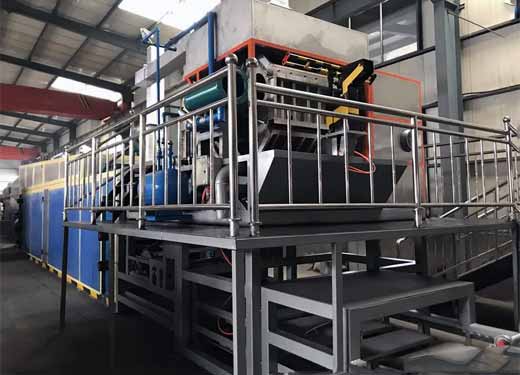Explanation of Pulp Molding Machine
Automation Pulp molding machines are used to manufacture various types of molded pulp products such as egg trays, fruit trays, and medical packaging. These machines require a high level of precision and consistency to produce high-quality products. Automation in pulp molding machines involves the use of computerized systems to control and monitor the production process, reducing the need for manual labor and human intervention.
Importance of Automation in Production Processes
Automation is becoming increasingly important in manufacturing industries due to its ability to improve efficiency, reduce labor costs, and increase production output. Automation in pulp molding machines can help to increase the accuracy and consistency of the production process, resulting in higher quality products. Additionally, automation can reduce the risk of errors and defects in the production process, ultimately leading to increased customer satisfaction.
Benefits of Pulp Molding Machine Automation
Automating the pulp molding process offers a range of benefits for manufacturers. With automation, machines can perform tasks with greater speed and accuracy, resulting in increased productivity and efficiency. This means that more trays can be produced in less time, helping businesses to meet demand and increase their profits.
Automation also reduces the need for manual labor, which can help to cut costs and reduce the risk of workplace injuries. By automating the process, workers are freed up to perform other tasks, while machines handle the more repetitive and physically demanding aspects of the job.
In addition to these benefits, automation also improves product consistency and quality. Machines can precisely control the amount of pulp used, the temperature and pressure during forming, and the drying time, ensuring that each tray is identical to the next. This helps to reduce waste and ensures that the final product meets the required standards.
Finally, automated machines have the ability to handle more complex designs and patterns, providing greater flexibility for manufacturers. This means that they can produce a wider range of products to meet the needs of their customers.
Types of Automation for Pulp Molding Machines
A variety of automation technologies can be integrated with pulp molding machines to improve their performance and productivity. Here are some common types of automation used in pulp molding machines:
- Programmable Logic Controllers (PLCs) PLCs are a type of industrial computer that can control various electromechanical processes, including pulp molding machines. They can be programmed to execute specific functions and communicate with other systems, such as sensors and motors. PLCs can help automate the entire pulp molding process, from material handling to product finishing.
- Industrial Robots Robots are widely used in manufacturing processes, including pulp molding. They can handle repetitive and labor-intensive tasks, such as loading and unloading trays, with speed and precision. Robots can also work alongside human operators to perform more complex tasks, such as quality inspection and pattern design.
- Automated Material Handling Systems Material handling is a critical part of pulp molding production, and automating this process can increase efficiency and reduce errors. Automated material handling systems can transport raw materials, molds, and finished products throughout the production line. They can also integrate with other automation technologies, such as robots and PLCs, to create a fully automated system.
- Computer-Aided Design (CAD) and Computer-Aided Manufacturing (CAM) software CAD and CAM software can help optimize the design and production of pulp molded products. CAD software can create 3D models of product designs, which can be used to generate accurate mold designs. CAM software can then use these designs to create tool paths for the pulp molding machines. This integration can improve the accuracy and consistency of product designs, while reducing waste and production time.
By incorporating these automation technologies, pulp molding machines can achieve higher levels of efficiency, productivity, and product quality.
Implementation of Pulp Molding Machine Automation
Automation can be a significant investment for any production facility, and implementing it in a pulp molding machine requires careful consideration and planning. Here are the key steps to implementing pulp molding machine automation effectively:
Evaluating production needs and goals Before implementing automation, it’s essential to evaluate your production needs and goals. Consider factors such as production volume, product complexity, and the level of customization required. This evaluation will help determine which automation technologies are suitable for your facility and which ones to prioritize.
Choosing the appropriate automation technologies Once you have identified your production needs and goals, it’s time to select the appropriate automation technologies. Some of the technologies that can be integrated into a pulp molding machine include PLCs, industrial robots, automated material handling systems, and CAD/CAM software. Choose the ones that best fit your specific production needs.
Training staff on new systems Implementing automation requires retraining your staff to work with the new systems. It’s essential to provide adequate training and support to ensure that your employees can work with the new technologies and that they feel comfortable with the changes.
Regular maintenance and updates Pulp molding machine automation requires regular maintenance and updates to ensure that the system runs optimally. Schedule regular maintenance checks and updates to identify and fix any issues before they become significant problems.
Cost-benefit analysis Finally, it’s crucial to conduct a cost-benefit analysis to determine whether the investment in automation is worth it. Consider factors such as increased productivity, reduced labor costs, and improved product consistency and quality. The cost-benefit analysis will help you determine the ROI of automation and the payback period of your investment.
Implementing automation in pulp molding machines can bring significant benefits to your production process, but it requires careful planning and execution. By following these steps, you can successfully integrate automation into your pulp molding machine and reap the benefits of increased efficiency, reduced costs, and improved product quality.
